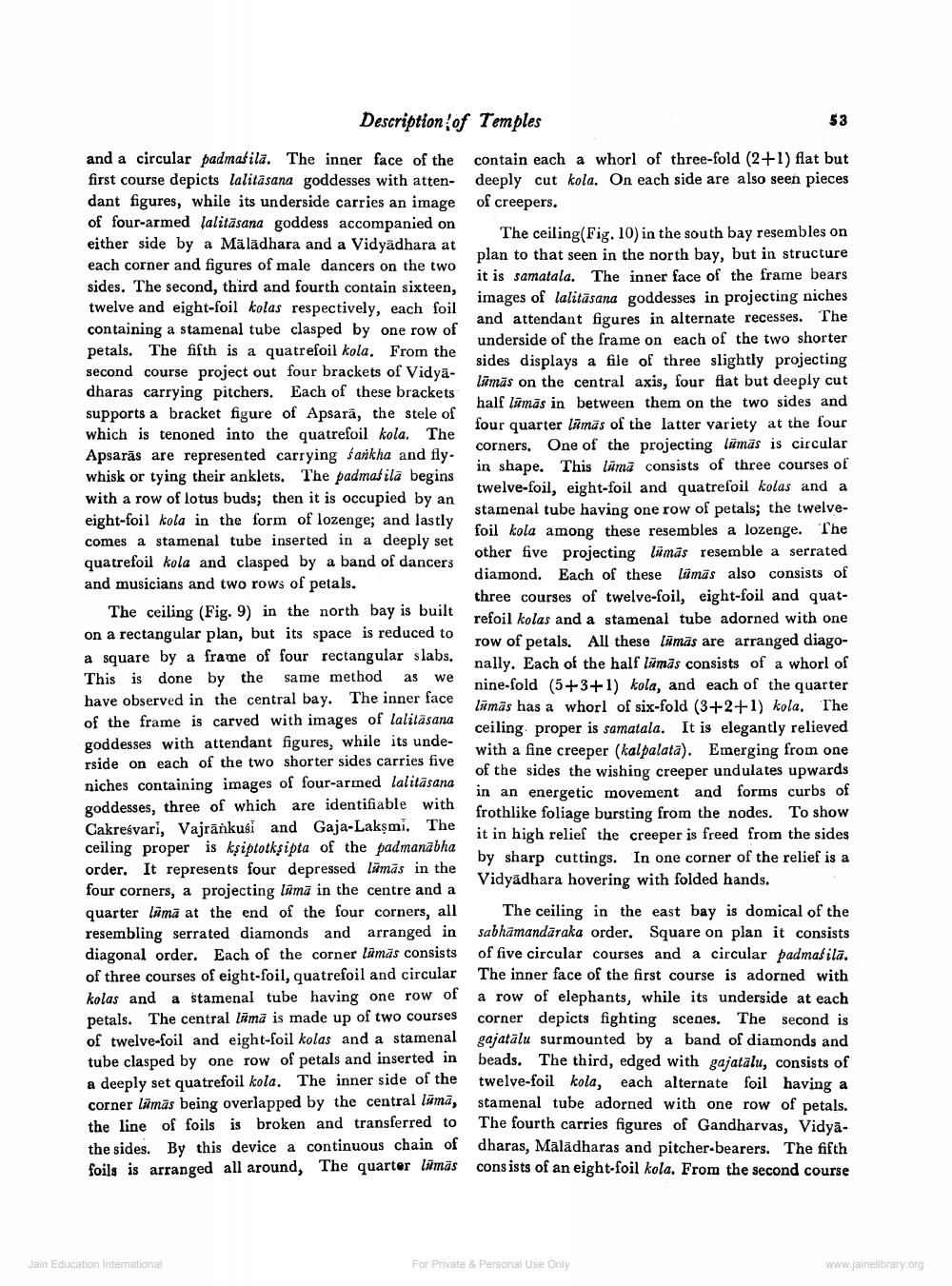________________
Description of Temples
53
and a circular padmašila. The inner face of the contain each a whorl of three-fold (2+1) flat but first course depicts lalitāsana goddesses with atten- deeply cut kola. On each side are also seen pieces dant figures, while its underside carries an image of creepers. of four-armed lalitasana goddess accompanied on either side by a Mālādhara and a Vidyadhara at
The ceiling(Fig. 10) in the south bay resembles on
plan to that seen in the north bay, but in structure each corner and figures of male dancers on the two
it is samatala. The inner face of the frame bears sides. The second, third and fourth contain sixteen, twelve and eight-foil kolas respectively, each foil
images of lalitäsana goddesses in projecting niches
and attendant figures in alternate recesses. The containing a stamenal tube clasped by one row of
underside of the frame on each of the two shorter petals. The fifth is a quatrefoil kola. From the
sides displays a file of three slightly projecting second course project out four brackets of Vidya
lämäs on the central axis, four flat but deeply cut dharas carrying pitchers. Each of these brackets
half lūmās in between them on the two sides and supports a bracket figure of Apsarā, the stele of
four quarter lümās of the latter variety at the four which is tenoned into the quatrefoil kola. The Apsarās are represented carrying Sarkha and fly.
corners. One of the projecting lumas is circular
in shape. This läma consists of three courses of whisk or tying their anklets. The padmašila begins with a row of lotus buds; then it is occupied by an
twelve-foil, eight-foil and quatrefoil kolas and a eight-foil kola in the form of lozenge; and lastly
stamenal tube having one row of petals; the twelve
foil kola among these resembles a lozenge. The comes a stamenal tube inserted in a deeply set quatrefoil kola and clasped by a band of dancers
other five projecting lümās resemble a serrated and musicians and two rows of petals.
diamond. Each of these limās also consists of
three courses of twelve-foil, eight-foil and quatThe ceiling (Fig. 9) in the north bay is built
refoil kolas and a stamenal tube adorned with one on a rectangular plan, but its space is reduced to
row of petals. All these Tāmās are arranged diagoa square by a frame of four rectangular slabs.
nally. Each of the half lamās consists of a whorl of This is done by the same method as we
nine-fold (5+3+1) kola, and each of the quarter have observed in the central bay. The inner face
lümās has a whorl of six-fold (3+2+1) kola, The of the frame is carved with images of lalitāsana
ceiling proper is samatala. It is elegantly relieved goddesses with attendant figures, while its unde
with a fine creeper (kal palata). Emerging from one rside on each of the two shorter sides carries five
of the sides the wishing creeper undulates upwards niches containing images of four-armed lalitäsana
in an energetic movement and forms curbs of goddesses, three of which are identifiable with
frothlike foliage bursting from the nodes. To show Cakresvari, Vajränkusi and Gaja-Lakşmi. The
it in high relief the creeper is freed from the sides ceiling proper is kşiptotkşipta of the padmanabha
by sharp cuttings. In one corner of the relief is a order. It represents four depressed lümās in the
Vidyadhara hovering with folded hands. four corners, a projecting luma in the centre and a quarter lämā at the end of the four corners, all The ceiling in the east bay is domical of the resembling serrated diamonds and arranged in sabhāmandaraka order. Square on plan it diagonal order. Each of the corner lamās consists of five circular courses and a circular padmašila. of three courses of eight-foil, quatrefoil and circular The inner face of the first course is adorned with kolas and a stamenal tube having one row of a row of elephants, while its underside at each petals. The central lüma is made up of two courses corner depicts fighting scenes. The second is of twelve-foil and eight-foil kolas and a stamenal gajatalu surmounted by a band of diamonds and tube clasped by one row of petals and inserted in beads. The third, edged with gajatalu, consists of a deeply set quatrefoil kola. The inner side of the twelve-foil kola, each alternate foil having a corner lümās being overlapped by the central lūmā, stamenal tube adorned with one row of petals. the line of foils is broken and transferred to the fourth carries figures of Gandharvas, Vidyathe sides Bv this device a continuous chain of dharas, Mālādharas and pitcher-bearers. The fifth foils is arranged all around, The quarter lūmas consists of an eight-foil kola. From the second course
Jain Education International
For Private & Personal use only
www.jainelibrary.org




